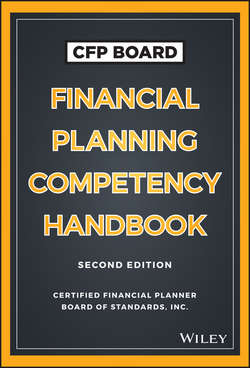Читать книгу CFP Board Financial Planning Competency Handbook - Board CFP - Страница 37
На сайте Литреса книга снята с продажи.
PART One
Introduction
CHAPTER 5
Fiduciary
ОглавлениеMartie Gillen, PhD
University of Florida
CONNECTIONS DIAGRAM
CFP Board’s Standards of Professional Conduct require that all CFP® professionals who provide financial planning services be held to the duty of care of a fiduciary. A fiduciary is defined by CFP Board’s Standards of Professional Conduct as “one who acts in utmost good faith, in a manner he or she reasonably believes to be in the best interest of the client” (p. 4). Individuals should always consider when the fiduciary standard applies. The Rules of Conduct address the fiduciary standard of care. Rule 1.4 provides direction to CFP® professionals who provide financial planning or material elements of financial planning to clients. The financial planner must adhere to ethical standards of professional conduct and fiduciary responsibility by providing unbiased recommendations that are in the best interest of the client. Violations may result in discipline of the CFP® professional.
INTRODUCTION
As defined by CFP Board’s Standards of Professional Conduct, a fiduciary is “one who acts in utmost good faith, in a manner he or she reasonably believes to be in the best interest of the client” (p. 4). CFP® professionals have a fiduciary responsibility to their clients when they are providing financial planning services or material elements of financial planning services. Professional judgment is at the forefront of acting as a fiduciary by recommending financial products or services that are believed to best serve the client. As detailed in the Rules of Conduct, Rule 1.4 regarding professionals who provide financial planning or material elements of financial planning to clients, the CFP® professional owes to the client the duty of care of a fiduciary as defined by CFP Board (p. 9).
A financial planner’s fiduciary status supersedes the baseline standard of care expected of all CFP® professionals. One who acts as a fiduciary has the highest ethical obligation to put the client’s best interests ahead of every other consideration as related to the principles of integrity, objectivity, fairness, and professionalism. How is a client’s best interest determined? Financial planners should identify the options, and should use their reasonable professional judgment to identify the best options based on client facts and circumstances. While it is impossible to review the infinite number of options, it is expected that the financial planner will provide the best services and recommendations available to reasonably meet the client’s needs, goals, and priorities.
Disclosure is needed when business or regulatory requirements may limit the types of products or services available to the client. Financial planners must disclose limitations to the client such as contractual or agency relationships that may potentially affect the client. Financial planners must also disclose to the client conflicts of interest; compensation structure, including compensation arrangements and any other sources of compensation; and costs of products and services, including all expenses the client will incur. A best practice is to follow up all verbal disclosures with written documentation. After a financial planning relationship exists, the fiduciary duty applies to all future services provided to that client by that planner. Violations may result in discipline of the CFP® professional.
LEARNING OBJECTIVE
The student will be able to:
a. Discuss the fiduciary standard and its importance to the planner–client relationship.
IN CLASS
PROFESSIONAL PRACTICE CAPABILITIES
Entry-Level: An entry-level personal financial planner can identify fiduciary duties and related parties.
Competent: A competent personal financial planner acts as a fiduciary for the client by evaluating options, making recommendations in the client’s best interests, and disclosing any limitations.
Expert: An expert personal financial planner acts as a fiduciary for the client by creatively and strategically evaluating options, making recommendations in the client’s best interests, and disclosing any limitations.
IN PRACTICE
Amanda
Amanda is a relatively new CFP® professional. She has been brainstorming ways to solicit new business, and makes a list of family members, friends, and acquaintances to call on for initial business. After talking with Amanda, her sister Tonya and Tonya’s partner Harley decide they could use a financial plan and would like Amanda to make recommendations. Amanda knows she must disclose to her clients any actual or perceived conflicts of interest, so she discusses with them the potential conflict of advising a family member. Amanda tells them that they would need open communication to explore their values, attitudes, expectations, and time horizons as those attitudes/orientations affect their goals, needs, and priorities. Amanda reminds them that she would need full disclosure, including in-depth quantifiable financial information, to be able to complete a comprehensive financial plan and make recommendations that would be in their best interests.
Visit www.wiley.com/go/wileycfpboard2e to access nearly 400 practice questions. Your access code is at the back of this book. CFP® professionals in the United States can also choose to obtain the full 28 credit hours by taking and passing the test.
